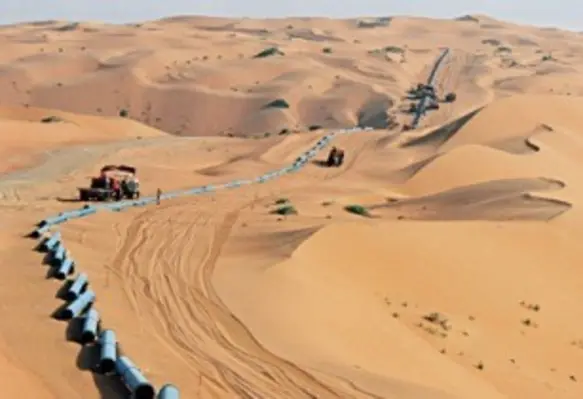Page 1 of 2Rising populations, economic growth and strong industrial activity have continued to put pressure on the Middle East Gulf’s precious natural gas resources
It may seem ironic in a land rich with hydrocarbons, but parts of the world’s leading oil producing region have become vulnerable in recent years because of the growing difference between demand and supply availability in the gas segment.
For the world’s biggest crude oil producer, Saudi Arabia, this has meant careful allocation of its gas resources to selected industrial areas and uses, as well as topping up any shortfall with oil.
In the absence of more gas availability, the kingdom’s power sector remains heavily dependent on burning oil, a costly and dirty option; as well as the environmental cost, the high oil consumption eats away potential export dollars lost from higher crude sales.
Kuwait is another gas hungry economy which, in this case, has turned to liquefied natural gas (LNG) imports from abroad to top up domestic supplies.
Dubai is also buying in LNG, while Abu Dhabi has long been supplied with Qatari gas via the cross-border Dolphin gas pipeline.
Qatar has played a fundamental role in feeding gas into the prosperous UAE economy, which uses gas for nearly all of its electricity production.
Abu Dhabi’s gas consumption has been increasing at a rate of 11 per cent a year.
It means, with gas in such high demand, but in apparently short supply, investment in new production and supply is expected to surge in the coming years, with Saudi Arabia leading the way.
Caught short
The striking thing is that in all of these cases, these are countries sitting on vast natural gas resources of their own.
Not to the tune of Qatar’s 25 trillion cubic metres (tcm) - surpassed only in the Gulf by Iran, with 33 tcm - but impressive numbers all around nonetheless.
According to BP’s most recent Statistical Energy Review, Saudi Arabia holds gas reserves of 8.2 tcm; the UAE 6.1 tcm; and Kuwait 1.8 tcm.
The only other Gulf countries with reserves that can compete with these are Iraq, with 3.6 tcm, and Oman, with 0.9 tcm.
Iraq is expected to see a huge surge in its reserves as more exploration investment filters through.
However, not all of these reserves are straightforward to extract, with plenty of sour gas, which contains high amounts of hydrogen sulphide, found in many parts of the Gulf.
Certainly when it comes to production, there has been little to compete with Qatar’s exploitation of the giant North Field, an offshore gas reservoir it shares with Iran.
Qatari production tallied 147 bcm in 2011, according to the BP figures.
In contrast, UAE production reached 52 bcm, while Kuwait’s stood at just 13 bcm.
Saudi Arabia’s production hit 99 bcm in 2011 - which has risen by more than 10 bcm for each of the past two years - although much of this is associated gas from oil production. And a large quantity of this is used for gas-lift and re-injection into the nation’s huge oilfields.
Of the rest, methane and ethane are consumed entirely by utilities and industry, while any excess propane, butane and natural gasoline not used by the domestic petrochemicals industry is exported.
From this perspective, Qatar’s decision to focus early on gas seems positively inspired.
Despite the abundance of resources all around, it has turned the Gulf into a region of haves and have-nots; or, more simply, a few Gulf states have just been caught short.
Production challenge Not surprisingly, the region’s biggest and most populated economy, Saudi Arabia, is taking action to redress the balance.
A decade ago, gas production was roughly half of what it is now in the kingdom. And state-owned energy giant Saudi Aramco is prioritising gas ventures, following a sustained period of upgrading its oil production and export capacity to meet the surge in oil demand in the run-up the global economic crisis of 2008.
But while Saudi’s gas production has risen sharply in recent years, in response to the keen demand for energy, figures in the UAE and especially Kuwait have been largely static.
This is changing in the UAE, where a number of major projects are underway that will significantly boost output there.
Saudi Arabia remains keenly active in the gas sector with a number of big projects taking shape.
These include the flagship Karan sour gas project, Aramco’s first non-associated offshore gas project, which is due to be completed in 2013.
It will feed vital new offshore gas supply via a 110 kilometre subsea pipeline to the Khursaniyah gas plant.
But the sour gas challenge means additional complexity and cost. The gas will be processed through three trains, and will include facilities for gas sweetening, acid-gas enrichment, gas dehydration and supplementary propane refrigeration.
Aramco has also begun drilling in the Hasbah and Arabiya offshore gas fields, located northeast of Dhahran and major progress has been made on the new Wasit gas plant, which will be one of the largest Aramco has ever built when completed in 2014.
Wasit will be the first in the kingdom to use Sulfinol-M gas treating technology to improve the efficiency of sulphur recovery up to 99.3 per cent.
Continues on page 2...










